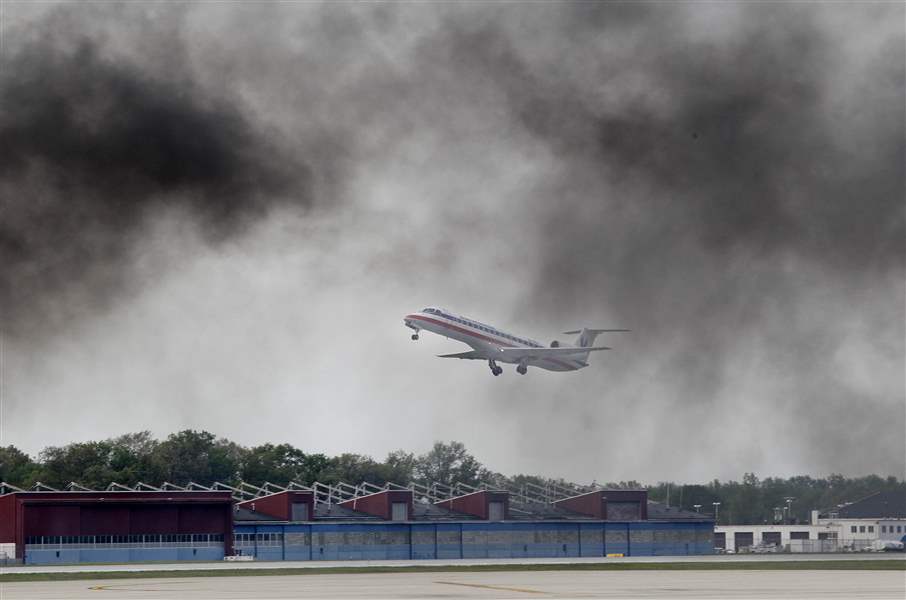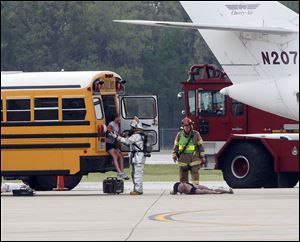
Emergency crews respond to mock drill at Toledo airport
5/2/2012
An American Eagle flight to Chicago flies over the tarmac during a disaster drill.
The Blade/Amy E. Voigt
Buy This Image

An American Eagle flight to Chicago flies over the tarmac during a disaster drill.
A passenger jet with 80 people aboard, mostly vacationers returning to Toledo, has skidded off a runway at Toledo Express Airport after a landing-gear failure, sparking a fire that killed an undetermined number and injured many more.
That was the scenario the Toledo-Lucas County Port Authority conjured up for a disaster drill today, with a retired cargo jet and a school bus filling in for the passenger jet and fire pans — tubs of diesel fuel ignited for smoke and flame effect — set up nearby.
Scores of firefighters, medical technicians, and other emergency workers from communities surrounding the western Lucas County airport responded to the scene, supplementing responders from the port authority’s police and fire department and the Ohio Air National Guard’s 180th Fighter Wing.
PHOTO GALLERY: Toledo Express disaster drill
Volunteer “passengers” — their ranks drawn from among airport employees, their friends, and local high school students — were evacuated, with some loaded onto ambulances, a few carried away aboard medical helicopters, and some declared dead at the scene.
In a real commercial airliner crash, port authority Sgt. Rick Gozdowski explained, bodies would be left exactly as found, to assist the National Transportation Safety Board in its investigation.
Federal law requires the port authority to conduct a live disaster drill at least once every three years at Toledo Express. During the cycle’s other two years, port officials and emergency-response officials conduct table-top preparedness exercises.
The drills’ main purpose, said Sergeant Gozdowski, is participating agencies’ “learning how to work together in a unified command,” coordinating their efforts and communicating with each other.
For the port authority’s emergency crew, which doubles as police and firefighters, it’s “how well we work with other agencies coming onto the airport who aren’t as familiar with the airport as we are,” he said.
“Even though this is a drill, we train like this is the real thing,” Sergeant Gozdowski said, while acknowledging that there are some safety-related limitations, like having off-airport departments come in on an immediate-response basis: no lights or sirens, and proceeding with caution across a live runway that would simply be shut down during a real incident.
Communication is vital, Airport Manager Steve Arnold agreed: “If that falls down early on, the whole drill is useless.”

Volunteer 'passengers' — their ranks drawn from among airport employees, their friends, and local high school students — were evacuated, with some loaded onto ambulances, a few carried away aboard medical helicopters, and some declared dead at the scene.
Such drills are also important for the surrounding communities’ fire departments to give them a taste of what they might have to deal with if a plane were to crash off airport property, Sergeant Gozdowski added.
While those fire departments would typically provide assistance to an on-airfield incident, he said, the port authority’s capacity to respond to an off-airfield crash is constrained by the need to maintain readiness at the airport, without which flight operations would have to halt.
More than a dozen agencies were represented among the drill’s participants.
“It [the disaster drill] gets us out here and it gets us going,” Capt. Richard Snyder, of the Whitehouse Fire Department, said while one of his trucks refilled with water at a hydrant on Air Cargo Parkway just off the airfield.
While firefighting foam wasn’t used during the drill because of its cost, testing how quickly trucks can refill and return to the crash scene is critical, the captain explained.
“With an aircraft, you’ve got a fuel fire, and you’ve got to have the water moving to get the foam out,” he said.
Both Sergeant Gozdowski and Mr. Arnold said they believe the airport is well prepared to deal with a disaster should one occur.
The drill doesn’t end when the last “patients” are gone and the fires are put out. A preliminary critique and evaluation is held before participants go home, the sergeant said, and there also is follow-up during monthly “Unified Command” meetings the port authority’s safety department oversees.
“We look at what went wrong, what went right — and then we work on the stuff that went wrong,” Sergeant Gozdowski said.
Contact David Patch at:
dpatch@theblade.com
or 419-724-6094.